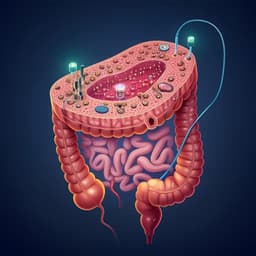
Engineering and Technology
Continuous Real-Time Hybrid Simulation Method for Structures Subject to Fire
X. Wang, R. E. Kim, et al.
Discover a groundbreaking continuous hybrid fire-simulation method that enhances real-time simulations of complex numerical models. This innovative approach, developed by Xuguang Wang, Robin E. Kim, Oh-Sung Kwon, In-Hwan Yeo, and Jae-Kwon Ahn, effectively manages elastic deformation in loading frames for accurate high-temperature structural behavior analysis.
~3 min • Beginner • English
Introduction
The paper addresses the challenge of accurately predicting structural performance under fire, moving beyond prescriptive member-level fire ratings toward performance-based design that captures system-level behavior and realistic fire hazards. Traditional prescriptive approaches (e.g., ASTM E119, CAN/ULC-S101, ISO 834) overlook system interactions, while numerical modeling of thermomechanical behavior is difficult due to temperature-dependent material degradation and changing boundary conditions. Full-scale fire tests are rare due to cost and logistical constraints. Hybrid fire simulation provides a practical alternative by physically testing critical components while modeling the remainder numerically. Building on prior hybrid fire testing, the authors propose and validate a continuous real-time hybrid fire-simulation method that overcomes drawbacks of ramp-and-hold control, enabling accurate, stable, and real-time simulation of structures subjected to fire.
Literature Review
Background references include standards and tools for fire assessment and testing (ASTM E119-18cel; CAN/ULC-S101; ISO 834; fire modeling with Hazard I, FIRECAM, and NIST’s FDS). Prior experimental studies evaluated member-level fire performance (e.g., Franssen et al. on steel columns; Kodur et al. on high-strength concrete), while system-level insights came from limited full-scale tests (e.g., Cardington). Hybrid fire testing methodologies and applications have been explored for various components and systems (Korzen et al.; Robert et al.; Mostafaei’s large-scale hybrid fire simulations), with work on stability in hybrid fire testing (Sauca et al.) and hybrid simulation of thermomechanical response (Whyte et al.). The authors’ earlier ramp-and-hold hybrid fire simulation (Wang et al., 2018) revealed limitations (specimen relaxation during holds, force buildup due to holding against thermal expansion, iteration sensitivity to increment size, and constraints on numerical model complexity), motivating the development of a continuous method.
Methodology
Overview: The proposed continuous hybrid fire-simulation framework decouples heat-transfer and structural analyses, uses a physical substructure for the fire-exposed member(s), and a numerical substructure for the remainder. A continuous, real-time control algorithm with error compensation is implemented via UT-SIM interfaced to a general-purpose actuator controller using NICON, which updates analog command signals at 100 Hz.
Heat-transfer analysis and thermal loading: Fire scenarios are defined using standard or parametric fire curves; here, ISO 834 is used. Heat transfer is modeled with Abaqus. Directly heated members are modeled in 3D to capture convection, conduction, and radiation; indirectly heated members are modeled with frame elements considering longitudinal conduction. Gas temperature history drives the 3D model; averaged cross-sectional temperatures are applied to frame elements as thermal boundary conditions for structural analysis.
Nonlinear structural analysis under thermal load: The governing equilibrium is F(u,T)=f, where restoring forces arise from both the experimental specimen and numerical model: Fr(u,T)+Fe(u,T)=f. Displacement increments are computed from Δu=−k−1(Fr+Fe−f), using the initial stiffness and no within-step iterations to maintain real-time synchronization with furnace temperatures. Force redistribution and displacement compatibility emerge through repeated stepwise solution as fire progresses.
Continuous command generation (extrapolation/interpolation): The displacement predicted at each analysis time step Δt is communicated from the numerical model to NICON. While the next prediction is computed, NICON extrapolates target displacements at δt=0.01 s using a third-order Lagrange polynomial based on the previous four target displacements; upon receiving the new target, NICON interpolates between the last three targets and the new one with a third-order polynomial. This provides a continuous actuator command trajectory, minimizing hold-induced artifacts and better matching the real loading path.
Error-compensation for loading-frame deformation: Direct specimen displacement measurement is impractical at high temperature. Specimen displacement is inferred by subtracting estimated loading-frame deformation from actuator stroke. At each δt: u_tot,n+1 = u_target,n+1,j + F_n,j / k_f, where k_f is the predefined loading-frame stiffness, and F_n,j is the previous measured force (used due to sampling latency). The resulting displacement error from using prior force is negligible given low strain rates and high controller update rates. The loading-frame stiffness k_f is evaluated in preliminary elastic tests; due to contact effects, actual loading-frame stiffness may be nonlinear elastic and differ from k_f, so careful calibration is required.
Stability analysis of the compensation scheme: A single-DOF analysis shows stability depends on ratios β_s = k_s/k_fa (specimen-to-frame actual stiffness) and β_f = k_f/k_fa (defined-to-actual frame stiffness). The iteration factor C = 1 – (1 + β_s(1 – β_f))^−1 must satisfy −1 < C < 1. Selecting k_f slightly higher than the actual frame stiffness (β_f > 1) enhances stability and avoids overshoot. Numerical validation illustrates convergence for β_f ≥ 1 and potential instability or overshoot for β_f < 1, especially when the specimen is stiff relative to the frame.
Hybrid simulation with multiresolution numerical model: The tested system is a 4-story steel building with perimeter moment frames (RBS connections) and gravity frames (modified from Jin & El-Tawil). One first-story perimeter column at the symmetry line is physically tested in a furnace; the rest is modeled in Abaqus. The RBS connection adjacent to the column is modeled with detailed 3D brick elements; other members use 3D frame elements. The connection end cross-section nodes are tied to a master node interfacing to a user element that exchanges the vertical DOF with the physical specimen. Material properties under elevated temperatures follow Eurocode 3.
Experimental program and setup: Four tests were conducted: A) heat-transfer test to obtain thermal boundary conditions; B) loading-frame stiffness evaluation within elastic range; C) ambient-temperature hybrid test to validate error compensation under gravity loading; D) continuous hybrid fire simulation under gravity plus ISO 834 heating (to 910°C) and cooling. The specimen was mounted fixed–fixed between loading frame (top) and a 10,000 kN actuator (bottom) inside a column furnace; thermocouples were installed along height. Displacement transducers were not used; actuator stroke and load cell force were recorded.
Control and timing: Analysis time step Δt=10 s; NICON updates commands at 100 Hz (δt=0.01 s) with extrapolation/interpolation between numerical updates. Gravity load applied in the numerical substructure remained constant; thermal loading applied to both physical and numerical substructures. Heating lasted 44 min; cooling followed (about 72–116 min depending on context).
Key Findings
- Preliminary calibration showed system stiffness nonlinearity due to contact in the loading frame; the elastic system stiffness ranged roughly 240–380 kN/mm, with specimen stiffness k_s ≈ 2,180 kN/mm, implying actual loading-frame stiffness k_fa ≈ 271–460 kN/mm.
- For stability, using a compensation stiffness k_f slightly higher than actual is beneficial; k_f = 500 kN/mm (β_f ≈ 1.09–1.84) yielded stable behavior. Numerical stability analysis indicated convergence for β_f ≥ 1 and potential instability/overshoot for β_f < 1, consistent with trial observations.
- Test C (ambient hybrid) demonstrated accurate error compensation: actuator tracked command displacement and the estimated specimen displacement matched the numerical target closely.
- Test D (continuous hybrid fire simulation) results:
• Initial gravity-phase specimen displacement differed among methods: continuous hybrid ≈ −1.93 mm vs. ramp-and-hold ≈ −0.74 mm and pure numerical ≈ −0.52 mm, attributed to assumed linear frame stiffness and compensation sensitivity at low loads; the difference was negligible relative to total thermal/plastic deformations.
• During heating (ISO 834 to ~910°C), continuous hybrid exhibited less force fluctuation than ramp-and-hold and showed earlier yielding (higher force levels) leading to smaller peak displacement than RH and numerical models.
• Force–deformation from continuous hybrid showed greater nonlinearity than pure numerical analysis at low temperatures, attributed to the 10 s time step (slower unbalanced force resolution during rapid temperature rise) and the linear frame stiffness assumption. At higher temperatures, nonlinearity reflects material degradation.
• The numerical model based on code material properties underestimated plastic deformation at high temperature compared with both hybrid tests.
• Cooling-phase responses (displacement and force histories) from continuous and ramp-and-hold tests were similar; strength recovered and force decrease rate reduced upon cooling.
- The continuous method eliminated hold-induced relaxation and reduced force fluctuations seen in ramp-and-hold, enabling longer analysis steps and use of more detailed FE substructures while maintaining synchronization via high-rate command updates.
Discussion
The continuous real-time hybrid simulation directly addresses limitations of ramp-and-hold by maintaining continuous actuator motion with predictive extrapolation and corrective interpolation, thereby minimizing specimen relaxation and artificial force buildup during holds. The error-compensation scheme, combined with a quantified stability condition based on stiffness ratios (β_s, β_f), provides practical guidance for reliable command generation despite uncertainty and mild nonlinearity in the loading-frame stiffness. Validation demonstrated that choosing compensation stiffness slightly above the actual frame stiffness stabilizes the simulation and avoids overshoot. The method captured key thermomechanical behaviors under fire, including earlier yielding and strength loss, and aligned well with hybrid benchmarks during cooling. Observed discrepancies at low temperatures and early heating are explained by modeling assumptions (linearized frame stiffness) and real-time constraints (10 s structural analysis step), suggesting improvements in frame characterization and adaptive stepping could further enhance accuracy. Overall, the method enables realistic, system-level fire response assessment using complex numerical substructures complemented by critical physical components.
Conclusion
- A continuous hybrid fire-simulation method was developed and validated, improving upon ramp-and-hold by continuously commanding actuator motion with extrapolation/interpolation and real-time error compensation. This enables longer analysis steps and incorporation of detailed FE substructures while maintaining synchronization with furnace temperatures.
- Accurate estimation of loading-frame stiffness is critical. The ratio between compensation and actual frame stiffness governs stability; selecting a compensation stiffness slightly higher than actual improves stability and mitigates force fluctuation, though an overly high value can introduce displacement bias. Ideally, the frame should behave linearly, and the compensation stiffness should closely match actual stiffness.
- The multiscale numerical substructure (detailed 3D brick model for RBS connections with frame elements elsewhere) was effectively integrated, demonstrating that the continuous method supports complex numerical models in hybrid fire simulations.
- The method accurately reproduced key behaviors under heating and cooling, with hybrid tests exhibiting greater nonlinearity and plasticity than code-based numerical predictions at high temperatures, underscoring the value of hybrid testing for validation.
Future work should focus on refining loading-frame characterization (including nonlinear effects), adaptive time stepping to better resolve rapid thermal transients, and expanding to multi-DOF control to simulate more realistic fire scenarios involving beam expansion-induced lateral and rotational demands.
Limitations
Validation was performed on an idealized scenario with simplifying assumptions: a single first-story column at the symmetry line was directly heated following ISO 834; adjacent members received heat only via longitudinal conduction (ignoring radiation and convection between members); interior beam thermal expansion effects were neglected due to apparatus limitations (vertical DOF only); and no fire protection insulation was modeled. The loading-frame stiffness was treated as linear for compensation despite observed nonlinear elastic behavior, introducing early-phase displacement bias. A relatively large analysis step (Δt = 10 s) may slow unbalanced force resolution during rapid heating. Results depend on accurate preliminary calibration of frame stiffness and thermal boundary conditions.
Related Publications
Explore these studies to deepen your understanding of the subject.







